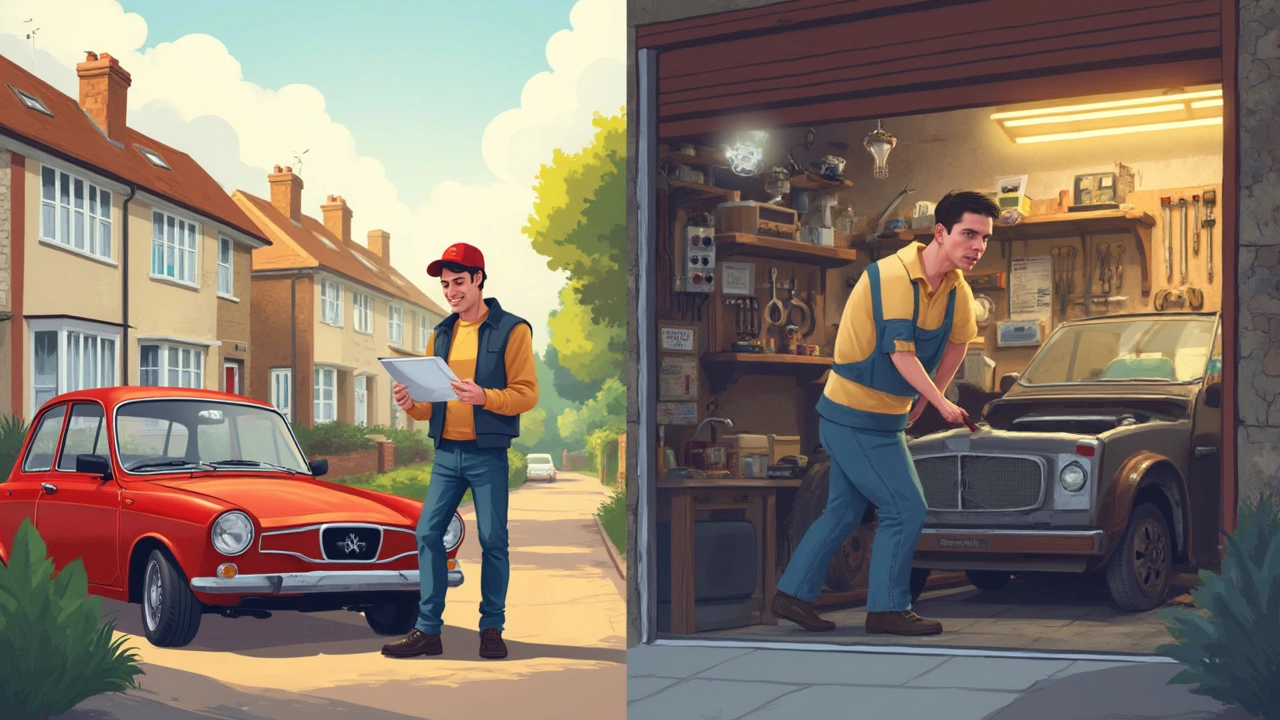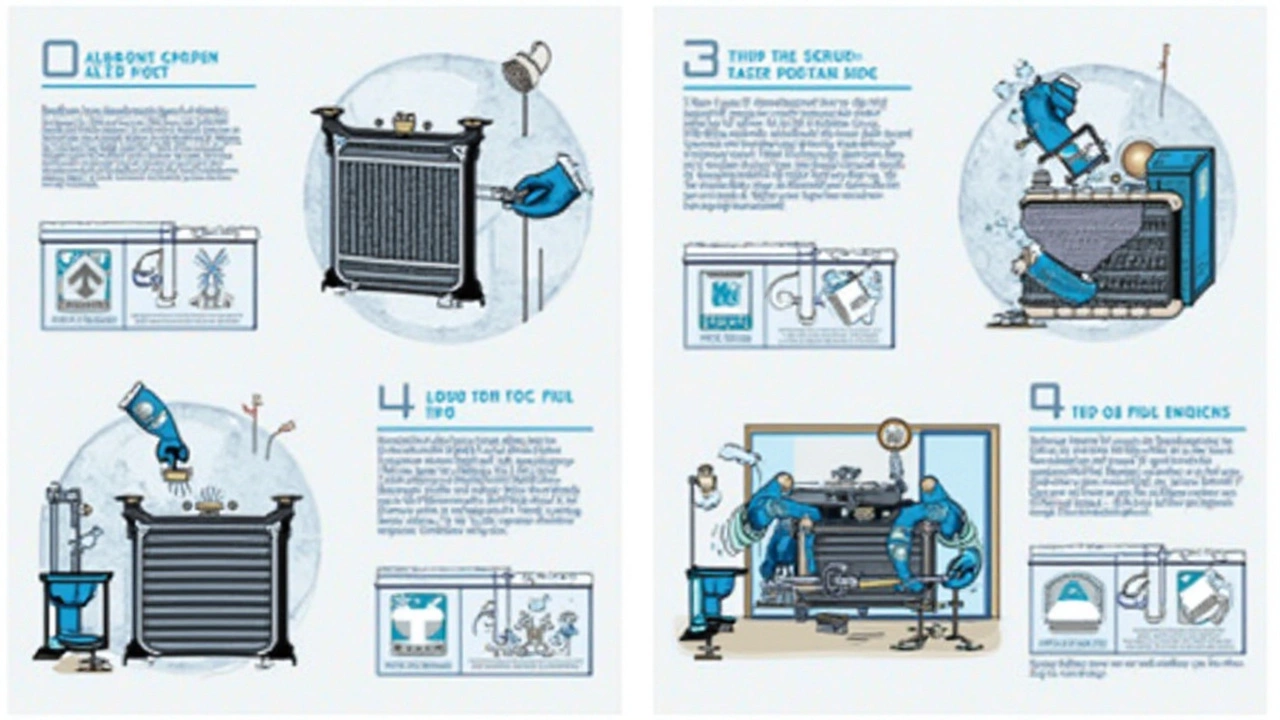If your car keeps overheating or you’re always topping up coolant, you might wonder how long it’ll actually take to swap out the radiator. Time is money, right? And being stuck without your ride for days is no fun. Let’s get straight to it—most radiator replacements take about 1.5 to 3 hours for a typical car, but there’s more to the story than just the clock.
Some radiators almost slip right out once you pop the hood. Others? Not so much. If you drive a tight-packed sedan or a car with extra bits in the way—like turbochargers, extra fans, or even big engine covers—plan on the job taking longer. DIY jobs sometimes get stuck on stubborn bolts or hoses that won’t budge. Even pros sometimes run into surprises.
Don’t rush it. Skipping steps or muscling through the job can mean leaks, overheating, or turning a short job into a weekend headache. Good prep saves you time, so it’s smart to gather all your tools, the right radiator, and fresh coolant before you start. I’ve seen people lose an hour just searching for a missing socket wrench.
- Why Radiator Replacement Matters
- Factors That Affect Replacement Time
- Typical Timelines: DIY vs Professional
- Pro Tips for a Faster Swap
- Avoiding Rookie Mistakes
Why Radiator Replacement Matters
Your car’s radiator isn’t just there for show. It keeps your engine from overheating by circulating coolant and pushing heat away while you drive. If it gives out, things go downhill fast—think sudden temperature spikes, engine knocking, or, in the worst case, a blown head gasket. That’s expensive, and way more hassle than just doing a radiator replacement.
Here’s why you shouldn’t ignore a funky radiator:
- Engine protection: Without a working radiator, your engine can blow in under 10 minutes of severe overheating.
- Better gas mileage: A healthy cooling system helps your engine run more efficiently, so you’re not burning extra fuel just to keep cool.
- No random breakdowns: Leaks leave you stranded, and nobody enjoys waiting for a tow truck on a hot day.
- Longer engine life: Regulary swapped radiators (every 5-10 years on average) mean major engine parts last a lot longer.
To put it in perspective, check out this quick comparison of what happens if you replace your radiator versus ignore it:
| Radiator Replaced | Radiator Ignored | |
|---|---|---|
| Engine Overheating | Rare | Common |
| Chance of Breakdown | Low | High |
| Repair Costs | $300–$900 (once) | $2,000+ (engine damage) |
| Peace of Mind | High | Low |
Ignoring your radiator is like asking for trouble, while swapping it out on time keeps your car cruising and your wallet happier in the long run.
Factors That Affect Replacement Time
Swapping out a radiator sounds simple, but there’s a bunch of stuff that can speed it up or slow it down. Knowing these things before you start can save you headaches, wasted time, and even money at the shop. Let’s dig into the main reasons why one person might be back on the road in two hours, while another’s still swearing in the driveway at sunset.
- Car Make and Model: Some cars have roomy engine bays and wide-open access. Others squeeze the radiator behind fans, brackets, or in tight nooks. Hondas and Toyotas, for example, are usually easier than, say, anything German or luxury, where lots of parts need to come off first.
- Skill Level: If you’re handy with tools and have replaced stuff under the hood before, you’ll probably move faster. Total beginners need to double-check manual steps, which adds time. And hey, there’s no shame in taking it slow if it’s your first time.
- Tools and Equipment: Having the right gear on day one is a big deal. Some radiators require special pliers for hoses or a bigger wrench for tough mounting bolts. Missing a tool stops you in your tracks.
- Age of the Car: Older cars can have rusted bolts, stuck hoses, or brittle plastic parts that snap when you look at them funny. That kind of stuff can eat up hours trying to fish out broken pieces or soaking bolts in penetrating oil.
- Radiator Design: Some aftermarket radiators are made to pop right in. Others don’t line up perfectly and need extra tweaking. OEM (original equipment manufacturer) parts usually fit better and go in quicker.
- Extra Steps: Depending on your setup, you might need to remove fans, shrouds, or even bumpers. Each add-on part is another step—and more time.
One other thing—coolant draining and burping the cooling system at the end can sneakily add half an hour, especially if you don’t get all the air out the first go. A lot of people forget about this last step and end up chasing mystery overheating problems after the swap. Double-check your manual for any special bleeding steps just to be sure.

Typical Timelines: DIY vs Professional
Trying to figure out if you should do a radiator replacement yourself or hand it off to a shop? Let’s look at what really happens in both cases, so you’re not guessing how long you’ll be car-less.
For professional mechanics, replacing a radiator usually lands in the 1.5 to 3 hour zone. Dealerships and larger shops sometimes run faster because they’ve got specialty tools and follow a set routine. If you schedule it early and parts are in stock, you could be back on the road before lunch. Smaller shops or busy seasons might push your wait to half a day, though.
Doing it yourself is a mixed bag. If you’re handy, have your tools ready, and nothing goes wrong, expect it to take about 2 to 4 hours. But first-timers can spend a lot longer. Some run into stuck connections or break a hose clamp and need a trip to the store. Online surveys show DIYers often underestimate their time—34% report taking five hours or more!
Here’s how the average radiator replacement stacks up for both:
| Method | Time Estimate | Skill Level Needed | Who Should Choose |
|---|---|---|---|
| Professional Shop | 1.5–3 hours | Certified Technician | Anyone who wants guaranteed speed and less mess |
| DIY | 2–5 hours (sometimes longer) | Basic car repair knowledge, patience | Enthusiasts, budget-conscious, or anyone who loves turning a wrench |
Some newer vehicles have tightly packed engine bays or extra sensors, especially hybrids and luxury models. In those cases, even the pros will take longer. Trucks and older cars with lots of room around the radiator? That’s usually an easier swap.
One last tip: if your car’s got an automatic transmission cooler built into the radiator, factor in more time for disconnecting and reconnecting the transmission lines. Either way, whether you go pro or try a DIY swap, the radiator replacement timeline boils down to your tools, your car, and your comfort level with car repairs.
Pro Tips for a Faster Swap
Want to make your radiator replacement as quick and painless as possible? A few smart moves can shave a good chunk of time off the job. Here’s what makes a difference when you’re in the garage—whether you’re a weekend DIYer or handing your keys to a pro.
- Get all your parts and tools ready first. This seems obvious, but it’s where most folks drop the ball. Double-check your parts list: radiator, coolant, clamps, new hoses if needed, and all the right tools (think socket set, screwdrivers, pliers, drain pan, rags). No one likes running to the parts store for a missing clamp halfway through.
- Let your engine cool completely. Hot coolant burns are no joke. Give the car a couple hours to cool off. You’ll work faster (and safer) with everything at room temp.
- Take photos before you disconnect anything. Use your phone to snap pics of hose and wire placements. This makes reinstalling everything way less stressful. If you forget, you’ll spend extra time guessing what goes where.
- Use penetrating oil on bolts and hose clamps ahead of time. A quick spray on rusty or stuck parts saves you from busted knuckles and wasted effort. Let it work for fifteen minutes before you start wrenching.
- Drain the cooling system fully. Open the radiator drain and remove the lower hose to keep coolant from spilling all over. Have an old towel handy for leaks that sneak by.
- Watch out for hidden trans cooler or oil cooler lines. Some vehicles, especially automatics, have extra lines running to the radiator. Unhook these carefully and plug them to avoid a mess and lost fluid.
- Don’t skip flushing the system. Flushing after pulling the old radiator keeps junk from clogging your new one. Fresh coolant means your repair lasts longer, too.
Wondering how pros slice through radiator jobs so fast? Here’s a quick look at how experience pays off versus being new at the task:
| Experience | Average Time (Hours) | Common Hang-ups |
|---|---|---|
| Professional Shop | 1.5 | Parts availability, hidden leaks |
| DIY (experienced) | 2 | Tight clearances, stubborn bolts |
| DIY (first time) | 3+ | Tool hunting, confusion over hose routing |
One last hack: stash every bolt and clip you remove in labeled bags. Reassembly is a breeze when you aren’t hunting for that one last fastener that rolled under your toolbox. And if you hit a snag, don’t force anything—check your manual or stop to look up a quick video. Often a five-minute search can save you hours fixing a mistake later.

Avoiding Rookie Mistakes
Replacing a radiator might look simple on YouTube, but it’s easy to mess things up if you miss the basics. Let’s go over the most common slip-ups and how you can dodge them. This info could save you from a headache or even a ruined engine.
The biggest rookie mistake? Not letting the car fully cool before starting. Hot coolant can burn you bad, and pressurized systems can spray the stuff everywhere. Always wait at least an hour after driving or check that the upper radiator hose is cool to the touch.
Next, lots of folks forget to disconnect the battery. It might seem unnecessary, but there are sensors and sometimes electric fans in the way. Accidentally shorting something with a wrench can turn a quick job into an electrical repair. Pop that negative terminal off before touching anything else.
Another classic newbie error is mixing up hose connections. Radiators usually have a top and bottom hose, and sometimes transmission cooler lines if your car’s automatic. Always snap a quick picture before you pull anything off—or label the hoses with tape. It’ll save you time and double-checking later.
Old hose clamps get overlooked, too. Those cheap metal rings lose their grip after years of heat, leading to future leaks. If you’re swapping your radiator, it’s smart to just grab new clamps—they’re cheap insurance against leaks.
- Always use fresh coolant—never reuse what you drained out. Old coolant often has debris or could be contaminated, which puts your new radiator at risk.
- Check for air pockets after refilling the system. Bleed out trapped air by running the engine with the heater on and radiator cap off until you see steady bubbles stop. Some cars need special bleeding steps—look up your model online first.
- Inspect the thermostat and hoses for wear while you’re in there. If they look cracked or swollen, now’s the time to swap them. No point doing half a job and going back in a month later.
Messing up any of these steps can mean leaks, overheating, or even damaging your engine. Triple-check your work before starting the car and keep an eye on the temp gauge the first drive after replacing your radiator. Don’t let impatience turn a simple job into an expensive fix.






